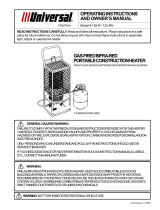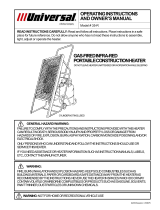Page is loading ...

OPERATING INSTRUCTIONS
AND OWNER’S MANUAL
READ INSTRUCTIONS CAREFULLY: Read and follow all instructions. Place instructions
in a safe place for future reference. Do not allow anyone who has not read these
instructions to assemble, light, adjust or operate this tool.
SPC-500
Model #
HOT SHOT
Model SPC-500
05/13 Revision L2 #72615
(Propane Torch)

2
Operating Instructions and Owner’s Manual
If you smell gas: (Under certain conditions odor may fade (Refer to page 6)
- Shut off gas to the device.
- DO NOT try to light appliance.
- Extinguish any open flame.
- Check the device for leaks using soapy water.
- DO NOT attempt to relight the device until all leaks are repaired and there is no
gas smell.
DO NOT use this device in areas where gasoline or other
liquids having flammable vapors are stored or used.
CAUTION:
This device is intended for outdoor use only.
NEVER direct torch flame toward hose or gas tank.
DO NOT leave torch unattended while in operation.
DO NOT stand or prop the torch on the burner end while in operation.
Always use the striker provided. Never use a match or lighter to ignite torch.
DO NOT apply heat or flame to tank to check for leaks or to increase gas pressure.
DO NOT lift tank by the valve.
When not in use the gas should be turned off at the LP gas tank(s).
CAUTION – In daylight, torch flame is barely visible.
DO NOT place hand or body part in the path of the flame while lighting or
operating torch.
This device is designed for vapor withdrawal from an LP gas tank(s) ONLY.
NOTE:
Place tank on level surface in an upright position.
Do not invert or lay tank on its side.
Gloves should be worn at all times when operating this device. Long sleeves, long
pants, and boots are recommended.
Have an ABC type fire extinguisher readily accessible to the job site.
Read and understand instructions before use!
Retain this information for future reference.
FOR YOUR SAFETY!
THE STATE OF CALIFORNIA REQUIRES THE FOLLOWING WARNING:
WARNING:
Combustion by-products produced when using this product contain carbon monoxide,
a chemical known to the State of California to cause cancer and birth defects (or other
reproductive harm).

3
Operating Instructions and Owner’s Manual
ITEM DESCRIPTION PART NO.
1....................... Handle Assembly ...........72601
2....................... Hose Assembly ..............72602
3....................... Striker ...........................72603
SPC-500-Parts List
CAUTION:
Use only genuine SCHEU PRODUCTS replacement parts. Never substitute parts.
Do not use modified parts. When ordering replacement parts,use the part number
located in these instructions.
When ordering repair parts, always furnish the following information:
1) Model Number
2) Part Number
3) Part Description
3
1
2

4
Operating Instructions and Owner’s Manual
1) Unpack all the components and inspect for any damage. If any damage is
discovered contact the delivery service or Scheu Products immediately.
2) Connect the hose assembly to the handle assembly and tighten
counterclockwise.
NOTE: This is a left-handed thread connection.
Connection to the Supply Tank:
NOTE: The LP (Liquid Petroleum) gas tank used with this device should be no less than a
20 lb. capacity. It should also meet or exceed NFPA 58 “Standard for the Storage and
Handling of Liquefied Petroleum Gases”.
1) Inspect the nut/nipple (excess shut-off valve) connection of the hose
assembly.Check for any dents or damage. The o-ring must be present. If
damage is found or the o-ring is missing call Scheu Products for the proper
replacement parts.
2) Connect the excess shut-off valve end of the host assembly to the shut-
off valve of a LP gas tank and tighten counterclockwise.
NOTE: If your LP gas tank does not have a shut-off valve, exchange the tank for
one with a shut-off valve.
OPERATING CHARACTERISTICS
Model BTU Operating Inlet Pressure
Temperature Range Range
SPC-500 500,000* -10
o
F to 100
o
F 17 psi to 170 psi
Assembly Instructions:
Un-assembled
Assembled
CAUTION:
This device is designed for vapor withdrawal from an LP gas tank(s) ONLY. Use of any
other gas may result in device failure or personal injury.
* Tank size and tank temperature can directly affect BTU output

5
Operating Instructions and Owner’s Manual
HOT SHOT
Model SPC 500
Assembly, Testing &
Operating Instructions
SCHEU PRODUCTS COMPANY
CAUTION:
DO NOT operate if any leaks are present. A leak may create a fire hazard.
DO NOT smoke around or expose supply tank(s) to open flames or sparks.
DO NOT apply heat or flame to tank to check for leaks. Excess heat may cause the
supply tank to rupture, possibly causing personal injury.
Lighting Instructions:
NOTE: The hose assembly is supplied with an excess flow control valve. Opening
the supply tank shut-off valve rapidly can cause the valve to close. If the excess flow valve
closes, close the supply tank shut-off valve. Open torch adjusting valve to release any
residual gas left in the hose. Close torch-adjusting valve and wait 30 seconds. Slowly open
tank shut-off valve.
1) Make sure torch adjusting valve is closed.
2) Open supply tank shut-off valve.
3) With torch nozzle pointed away from any flammable material, open torch
adjusting valve 1/8
th
of a turn or until you can hear gas escaping.
4) Ignite using supplied igniter.
5) Use the torch-adjusting valve to control the size and heat of flame.
USE: When using tool, do not direct flame directly into wind.
Do not allow barrel to come closer than 6” to the surface being heated.
Failure to do either of these things could cause flame outage.

6
Operating Instructions and Owner’s Manual
WARNING
Asphyxiation Hazard
• Do not use this heater for heating human living
quarters.
• Do not use in unventilated areas.
• The flow of combustion and ventilation air must
not be obstructed.
• Proper ventilation air must be provided to support
the combustion air requirements of the heater
being used.
FUEL GAS ODOR
LP gas and natural gas have man-made odorants added specifically for detection of fuel gas leaks.
If a gas leak occurs you should be able to smell the fuel gas. Since Propane (LP) is heavier than air you
should smell for the gas odor low to the floor.
ANY GAS ODOR IS YOUR SIGNAL TO GO INTO IMMEDIATE
ACTION!
• Do not take any action that could ignite the fuel gas. Do not operate any electrical switches. Do not pull any
power supply or extension cords. Do not light matches or any other source of flame. Do not use your
telephone.
• Get everyone out of the building and away from the area immediately.
• Close all propane (LP) gas tank or cylinder fuel supply valves, or the main fuel supply valve located at the
meter if you use natural gas.
• Propane (LP) gas is heavier than air and may settle in low areas. When you have reason to suspect a
propane leak, keep out of all low areas.
• Use your neighbor’s phone and call your fuel gas supplier and your fire department. Do not re-enter the
building or area.
• Stay out of the building and away from the area until declared safe by the firefighters and your fuel gas
supplier.
• FINALLY, let the fuel gas service person and the firefighters check for escaped gas. Have them air out the
building and area before you return. Properly trained service people must repair any leaks, check for further
leakages, and then relight the appliance for you.
ODOR FADING - NO ODOR DETECTED
• Some people cannot smell well. Some people cannot smell the odor of the man-made chemical added to
propane (LP) or natural gas. You must determine if you can smell the odorant in these fuel gases.
• Learn to recognize the odor of propane (LP) gas and natural gas. Local propane (LP) gas dealers will be more
than happy to give you a scratch and sniff pamphlet. Use it to become familiar with the fuel gas odor.
• Smoking can decrease your ability to smell. Being around an odor for a period of time can affect your
sensitivity to that particular odor. Odors present in animal confinement buildings can mask fuel gas odor.
• The odorant in propane (LP) gas and natural gas is colorless and the intensity of its odor can fade
under some circumstances.
• If there is an underground leak, the movement of gas through the soil can filter the odorant.
• Propane (LP) gas odor may differ in intensity at different levels. Since Propane (LP) gas is heavier than air,
there may be more odor at lower levels.
• Always be sensitive to the slightest gas odor. If you continue to detect any gas odor, no matter how
small, treat it as a serious leak. Immediately go into action as discussed previously.
ATTENTION - CRITICAL POINTS TO REMEMBER!
• Propane (LP) gas has a distinctive odor. Learn to recognize these odors. (Reference Fuel Gas Odor and Odor
Fading sections above.
• Even If you are not property trained in the service and repair of the heater, ALWAYS be consciously aware
of the odors of propane (LP) gas and natural gas.
• If you have not been properly trained in repair and service of propane (LP) gas then do not attempt to light
heater, perform service or repairs, or make any adjustments to the heater on the propane (LP) gas fuel
system.
• A periodic sniff test around the heater or at the heater’s joints; i.e. hose, connections, etc., is a good safety
practice under any
• Refer to the specification section of the heater’s
manual, heater dataplate, or contact the Scheu
Products Company to determine combustion air
ventilation requirements of the heater.
• Lack of proper ventilation air will lead to improper
combustion.
• Improper combustion can lead to carbon monoxide
poisoning leading to serious injury or death.
Symptom of carbon monoxide poisoning can
include headaches dizziness and difficulty in
breathing.
ODOR FADE WARNING

7
Operating Instructions and Owner’s Manual
Shut-Off Instructions:
1) Close torch adjusting valve.
2) Close supply tank shut-off valve.
3) Open the torch-adjusting valve briefly to release any residual gas left in
the hose.
Maintenance:
Prior to each use:
1)Visually inspect all components of the device for damage and or wear. If the
hose shows excessive abrasion wear, or the hose is cut, it must be replaced
prior to operation. If damage is found, contact Scheu Products Co. for the
proper replacement parts.
2)Visually inspect LP gas tank(s) for dents, damage to collar, damage to shut-
off valveor corroded foot ring. If any of these are present the LP gas tank(s)
must be replaced prior to operation.
3)Perform a leak test according to the leak test procedure described on page 5.
4)Ignite torch according to the lighting instructions described on page 5. Check
operation of the adjusting valve and the other components prior to proceeding.
Periodically:
1)Remove any debris or combustible material from the torch. The torch must be kept
clear and free from combustible materials.
2)The surface of the device should be cleaned with soap and water. Do not use
petroleum-based or flammable cleaner on any part of the device.
Disconnecting the Supply Tank:
1)Make sure supply tank valve is shut off.
2)Open torch adjusting valve briefly to release any residual gas left in the hose.
Close adjusting valve when complete.
3)Disconnect the P.O.L. nut/nipple located at the end of the hose assembly from the
supply tank(s).
4)Replace the protective plastic cap and plug to the hose end and
supply tank(s) respectively.
CAUTION:
DO NOT smoke around or expose supply tank(s) to open flame or sparks.
Always use the striker provided. Never use a match or lighter to ignite torch. Use of
device other than the striker may cause personal injury.
DO NOT place hand or any body part in the path of the flame while lighting or operating
torch. This can result in personal injury.
CAUTION:
DO NOT smoke around or expose supply tank(s) to open flames or sparks.
Torch end of handle assembly will increase in temperature immediately after shutting off.

8
Operating Instructions and Owner’s Manual
Storage:
Never store a torch that is still hot. When the torch is stored indoors, the connection
between the LP gas tank(s) and the device must be disconnected and the tank(s) removed
from the device and stored outdoors in accordance with Chapter 5 of the “Standard for the
Storage and Handling of Liquefied Petroleum Gases” ANSI/NFPA 58.
NOTE:
· Storage temperature shall not exceed 120degrees F (49 degrees C).
· Place tank on level surface in an upright position. Do not invert or lay tank on its side.
Safety Information:
Safety publications related to safe practice and use:
CSA 2-94 “U.S. Requirements for Hand Held LP Torches for use with fuel supply”
ANSI Z49.1 “Safety in Welding and Cutting”
NFPA 54 “National Fuel Gas Code”
NFPA 58 “Standard for the Storage and Handling of Liquefied Petroleum Gases”
CAUTION:
DO NOT smoke around or expose supply tank(s) to open flames or sparks.
CAUTION:
DO NOT smoke around or expose supply tank(s) to open flame or sparks.
The hose assembly shall be protected from traffic, crushing, and hot surfaces. This may
cause premature wear of the hose.
DO NOT lift tank by the valve. Lifting the tank by the valve may result in damage to
the valve.

9
Operating Instructions and Owner’s Manual
Scheu Products Co. reserves the right to make changes at any time, without notice
or obligation, in colors, specifications, accessories, materials and models.
WARNING:
USE ONLY MANUFACTURER’S REPLACEMENT PARTS. USE OF ANY OTHER PARTS COULD
CAUSE INJURY OR DEATH. REPLACEMENT PARTS ARE ONLY AVAILABLE DIRECT FROM THE
FACTORY AND MUST BE INSTALLED BY A QUALIFIED SERVICE AGENCY.
PARTS ORDERING INFORMATION:
PURCHASING: Accessories may be purchased at any Scheu Products Co. local
dealer or direct from the factory
FOR INFORMATION REGARDING SERVICE
Please call Toll-Free 800-325-7057
www.allpro-heaters.com
Our office hours are 7:00 AM – 4:00 PM, PT, Monday through Friday.
Please include the model number, date of purchase, and description of problem in all
communication.
OPERATING INSTRUCTIONS
AND OWNER’S MANUAL
SPC 500
Model #
LIMITED WARRANTY
Scheu Products Co. warrants its HOT SHOT to be free from defects in material
and workmanship for a period of 90 days from date of purchase. Scheu
Products Co.will repair or replace this product free of charge if it has been
proven to be defective within the 90 day period, and is returned at customer
expense with proof of purchase to Scheu Products Co. within the warranty
period.
/



